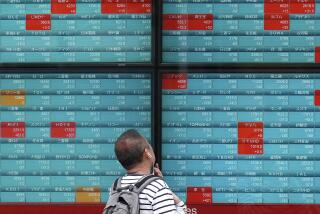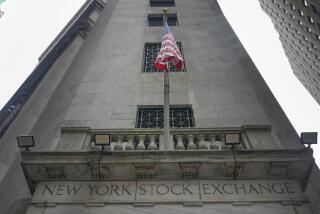Strategy pays off for Goldman Sachs
- Share via
Standing atop the wreckage of sub-prime mortgage securities and the resulting seizure in the credit markets is Goldman Sachs Group Inc., increasingly perceived as the world’s biggest hedge fund
Although Goldman, the largest Wall Street firm by market value, insists that it caters to the needs of clients and has never been anything but customer-driven, the company is considered No. 1 among its peers in so-called proprietary trading -- investing with its own capital.
Like hedge fund management firms that are posting their highest returns, Goldman is profiting substantially from allowing its traders to speculate on whether the price of assets will fall or rise.
Goldman’s third-quarter earnings soared 79% to almost $2.9 billion after the New York-based firm, led by Chairman and Chief Executive Lloyd Blankfein, took positions that rose in value as the price of mortgage-backed securities declined.
It posted record fixed-income trading revenue of $4.9 billion in the third quarter, exceeding the combined tally of Morgan Stanley, Lehman Bros. Holdings Inc. and Bear Stearns Cos. Analysts estimate that Goldman will post record earnings of almost $11 billion this year.
“Out of this carnage of the summer, it was clear there were going to be huge opportunities because for all the managers who blew up, there were sure to be a bunch that exploited the situation,” said Bill Grayson, president of Falcon Point Capital, a San Francisco-based hedge fund manager.
While Goldman used hedging strategies to prosper in the third quarter, Merrill Lynch & Co., Bear Stearns and UBS weren’t so nimble when the sub-prime tide ran out. The divergence came after three years during which earnings at the top investment banks rose almost in lock-step.
Merrill, the biggest U.S. brokerage, and Zurich-based UBS, Europe’s largest bank, reported their first quarterly losses in more than 4 1/2 years after mortgage-related write-downs. Bear Stearns, the No. 5 U.S. securities firm, posted its biggest earnings drop in a decade.
Goldman, meanwhile, has been using its capital to take bigger trading risks than rivals. The firm’s so-called value at risk, a measure of how much the bank estimates it could lose from trading in a single day, rose to $139 million in the third quarter, up 51% from a year earlier to the highest level ever, according to company reports. The increase was most pronounced in interest-rate-related risk, which almost doubled to account for about 40% of the total.
Not all of Goldman’s traders have been successful. Global Alpha, a $6-billion hedge fund managed by Goldman, run by Mark Carhart and Ray Iwanowski, lost almost 35% in the year through September after shedding 6% in 2006. Another fund, Global Equity Opportunities, dropped 30% in the first two weeks of August, prompting Goldman to inject $1 billion from investors and $2 billion of its own capital into the fund.
But shares of Goldman are trading almost as if the market swoon of July and August never happened. Although the stock slumped Monday along with those of other Wall Street firms, it has surged 38% since falling to a 52-week low in mid-August.
Year to date, Goldman’s stock is up 14%, the best performance of the five biggest U.S. securities firms. Morgan Stanley is up 0.5%; Merrill, Lehman and Bear Stearns are down 20% or more.
“There’s kind of a love fest going on with Goldman right now, as they were able to weather the sub-prime storm much better than anyone else,” said Peter Kovalski, who helps manage more than $12 billion at Purchase, N.Y.-based Alpine Woods Investments, which holds shares of Goldman and Merrill. “They’re one of the best-run investment banks out there.”
More to Read
Inside the business of entertainment
The Wide Shot brings you news, analysis and insights on everything from streaming wars to production — and what it all means for the future.
You may occasionally receive promotional content from the Los Angeles Times.










